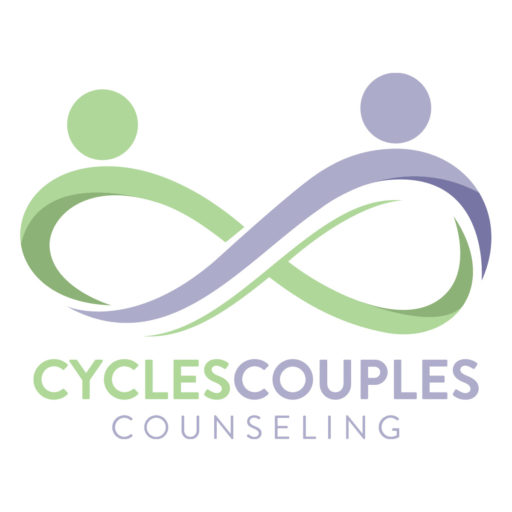How do we figure out if we’re in a cycle?
Do you ever feel like you and your partner have the same argument over-and-over again? Find yourself stuck in the same relationship patterns no matter who you date? Does it feel like you end up with the same outcome, regardless of how many times you and your partner talk it through?
If so, you may be stuck in a negative cycle.
While often clients enter EFT therapy because of repetitive fights over a specific topic like sex, anxiety or child rearing etc., therapists find that regardless of the content of the argument, the structure of the negative cycle is the same.
That's right...it's all the same.
What is a negative cycle?
In Emotionally Focused Therapy, therapists help clients to identify the structure of this self-sustaining downward spiral--the more I____ , the more you _______ and off we go. While the content may change, the process remains the same.
The way we respond to disconnection and distress unintentionally creates more disconnection and distress and that is the crux of this awful seemingly inescapable pattern.
By noticing this interaction cycle clients can more clearly separate this from their relationship and fight this common enemy together, rather than falling victim to the "blame game," and other forms of disconnection.
Common Negative Cycles
Each cycle is unique to your relationship. Common influential factors are personality, past incidences of trauma, childhood dynamics and even past relationships. Most likely though, couples fall into three patterns.
Find the Bad Guy
In this cycle, partners blame each other for issues within the relationship. Unfortunately, this often escalates into name-calling, hostility or other negative reactions. This constant finger pointing seems to say, “It’s all your fault.”
This negative cycle is hard to maintain as it takes so much constant energy. Consequently, this is seen most with partners who have more assertive and strong personalities. Typically, as one partner burns out, it begins to looks like one of the other two cycles below.
“Find the Bad Guy” is a quickly escalating cycle. As one partner accuses, the other blames back. As partners fight to be right, they continuously point fingers and bring up evidence about who’s more wrong.
This cycle is unproductive—as one blames, the other blames back and round and round they go.
Rarely do partners in this pattern share about their internal vulnerable emotions. Both feel misunderstood and attacked as they continue to call each other out.
Check out this Brene Brown video about blaming.
Pursue & Withdraw
Most couples tend to find themselves in this popular negative cycle of interaction. It appears like a nonconsensual game of tag—as one constantly chases, the other constantly runs.
The pursuer in this cycle fights to bring closeness and connection in the relationship. They are usually the first to notice any signs of relationship distance. They sound the alarm and attack the problem. Think of them like protesters. They want to fight against separation.
Unfortunately, because of the strategies partners like this use, they often get villainized. They look aggressive, blaming, or lecturing. Pursuers tend to use tone, volume and assertiveness to advocate for their bond.
The withdrawer in this cycle looks almost opposite. Their intention is to buckle down and prevent things from getting worse in the relationship. They typically are very anxious and want to fix things and make it all better, on the inside. However, on the outside this looks very different.
Withdrawers tend to get silent, avoid, leave and even curl up with their body to shut down any more negative interactions. Occasionally this can look like subject changes, or using humor, however, often to the pursuer it can feel dismissing or at worst, abandoning.
The more the pursuer protests the disconnection; the more the withdrawer gets worried and avoids the reactivity to protect from further damage. The more the withdrawer sidesteps, the more the pursuer has to grab their megaphone to call attention. The more the pursuer protests, the more the withdrawer checks out.
This is the outline of a terrible self-sustaining negative cycle.
Avoid—Avoid
Rarely do therapists see these couples in session. This cycle is most dangerous and prone to detachment because of its silent, but deadly nature. Once in a blue moon you will see two avoidant partners together. However, this negative cycle mostly occurs when the pursuing partner starts to burn out and is too tired to protest.
With this negative cycle, both partners are withdrawn. Neither is fighting for connection in the relationship. Quietly, they are both checking out and drifting apart.
The more one shies away, the more the other sees that as a sign of disconnection and their cue to be more independent and vice versa. Slowly, and silently, they become more and more disengaged.
While on the outside these couples tend to seem very reserved, shy and polite, on the inside they are typically brooding with resentment and unacknowledged emotional needs.
This cycle is the most risky. Most partners get here as a last resort after tons of failed attempts and exhaustion. If you find this fits your relationship, you should seek counseling ASAP to prevent full detachment.
How do we shift out of this pattern?
The first step is to understand your dance. It’s important to be able to identify when you and your partner start to fall victim to a negative cycle. This dynamic has been sneaking up on you two for weeks, months or sometimes even years. Remember, it might be difficult to recognize it at first.
The goal is to notice how you get stuck in that cycle, so you can start to team up against it. The negative cycle is your enemy, not your partner!
Next, in order to shift out of this cycle you need two important ingredients—vulnerability and authenticity. The dance you both find yourself in is completely superficial. Rarely, if ever, is there deep emotional connection.
Your reactivity fuels this self-sustaining loop in the forms of icy shut downs and fiery start-ups. By taking a vulnerable risk and showing your partner what’s behind your actions in the cycle you can break this pattern. No guts, no glory.
Let’s do something different.
We get it. Easier said than done. It takes so much bravery to drop your weapons and defenses in your negative cycle. It’s like empathy and vulnerability expert Brene Brown always states, “Courage over comfort.”
It’s crucial to understand why you think you need these responses in your relationship. Identifying what makes you feel so unsafe and what you are hoping happens between the two of you is important to share with your partner.
Do you worry if you don’t fight that no one will?
Are you trying to get your partner to understand your pain so that it won’t keep hurting?
Is it just plain terrifying to think about being alone and losing your partner? Is that why you’re always fighting to connect?
If you don’t share these reasons with your partner, you run the risk of your actions in the cycle being villainized. You need to offer them a softer view of your efforts and what they are intending to accomplish.
Do you fear if you get it wrong that you will lose them? Is that why you’re always quiet?
Do you worry if you spoke up they might not understand or even worse, decide they don’t want you anymore?
Are you nervous you could fail them?
You must express your intentions. Letting your partner see your fear and pain can change the tone of your exchange. If you can comfort your partner in times of insecurity like this, you can overpower this negative cycle.
After all, it’s clear. The ways you are trying to make things better are ineffective. You keep missing the connection. Let’s do something different!
The ideal picture: security
Although it would be lovely if you never fought again, that is far too idealistic. Healthy and secure couples still argue. Every couple has a negative cycle unique to their partnership.
The objective of couples counseling is not to rid your relationship of a negative cycle completely. It’s more to help you and your partner learn what to do when a cycle happens, how to de-escalate and stay connected.
Research tells us emotional responsiveness keeps couples secure. Sue Johnson, the founder of Emotionally Focused Therapy, commonly refers to this as “A.R.E. you there for me?”
Accessibility: Can I reach to you?
Responsiveness: Can I rely on you to be there for me?
Engagement: Do you value me enough to stay close and interactive?
We know couples that have these types of conversations can de-escalate their negative cycles and begin to strengthen their relationship.
It’s in the name! Let’s get a grip on your cycle. Let’s do something different!
At Cycles Couples Counseling, we specialize in cycles and helping couples develop secure relationships and grow closer. Call us today and schedule a free consultation!
Learn more about EFT Therapy in California.


